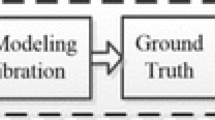Abstract
The application of computer-aided controversial plays resolution in sport events significantly benefits organizers, referees and audience. Nowadays, especially in ball sports, very accurate technological solutions can be found. The main drawback of these systems is the need of complex and expensive hardware which makes them not affordable for less-known regional/traditional sports events. The lack of competitive systems with reduced hardware/software complexity and requirements motivates this research. Visual Analytics technologies permit system detecting the ball trajectory, solving with precision possible controversial plays. Ball is extracted from the video scene exploiting its shape features and velocity vector properties. Afterwards, its relative position to border line is calculated based on polynomial approximations. In order to enhance user visual experience, real-time rendering technologies are introduced to obtain virtual 3D reconstruction in quasi real-time. Comparing to other set ups, the main contribution of this work lays on the utilization of an unique camera per border line to extract 3D bounce point information. In addition, the system has no camera location/orientation limit, provided that line view is not occluded. Testing of the system has been done in real world scenarios, comparing the system output with referees’ judgment. Visual results of the system have been broadcasted during Basque Pelota matches.




















Similar content being viewed by others
Notes
References
Ahn S (2004) Least squares orthogonal distance fitting of curves and surfaces in space. In: Lecture notes in computer science. Springer (2004). http://books.google.es/books?id=we4cHJBFzLwC
Alper Yilmaz OJ, Shah M (206) Object tracking: a survey. ACM Comput Surv 38(4). doi:10.1145/1177352.1177355
Cavallaro R (1997) The foxtrax hockey puck tracking system. IEEE Comput Graph Appl 17:6–12
Erik Cueva DZ, Rojas R (2005) Kalman filter for vision tracking. Freie Univ., Fachbereich Mathematik und Informatik
Yan F, Christmas W, Kittler J (2005) A tennis ball tracking algorithm for automatic annotation of tennis match. In: British machine vision conference, vol 2, pp 619–628
Sullivan GJ, Topiwala PN, Luthra N (2004) The h.264/avc advanced video coding standard: overview and ntroduction to the fidelity range extensions. In: SPIE 49th annual meeting optical science and technology, international society for optics and photonics, pp 454–474
Gopal Pingali Agata Opalach YJ (2000) Ball tracking and virtual replays for innovative tennis broadcasts. In: Proceedings 15th international conference on pattern recognition, 2000, vol 4. IEEE, pp 152–156
Haines E, Akenine-Moller T (2002) Real-time rendering, 2nd edn. AKPeters
Innovations HE (2013) Hawk-eye accuracy and believability. http://www.hawkeyeinnovations.co.uk/
Isard M, Blake A (1998) Condensation—conditional density propagation for visual tracking. Int J Comput Vis 29(1):5–28
Inurrategi ML, Olaizola IG, Ugarte A, Macia I (2008) Tv sport broadcasts: real time virtual representation in 3d terrain models. In: 3DTV conference: the true vision—capture, transmission and display of 3D video, 2008. IEEE, pp 405–408
Miller FP, Vandome AF, McBrewster J (2009) MPEG-2: lossy compression, video compression, audio compression (data), ATSC (standards), MPEG transport stream, MPEG-1 audio layer II, H. 262/MPEG-2 Part 2, MPEG-4, advanced audio coding. Alpha Press. http://dl.acm.org/citation.cfm?id=1822909
Owens N, Harris C, Stennett C (203) Hawk-eye tennis system. In: International conference on visual information engineering, VIE 2003. IET, pp 182–185
Naidoo WC, Tapamo JR (2006) Soccer video analysis by ball, player and referee tracking. In: Proceedings of the 2006 annual research conference of the South African institute of computer scientists nd information technologists on IT research in developing countries. South African Institute for Computer Scientists and Information Technologists. pp 51–60
Richardson IE (2003) The H.264 advanced video compression standard, 2nd edn. Vcodex Limited, UK
Richardson IEG (2002) Video codec design: developing image and video compression systems. Wiley
Wu W (2010) Tennis touching point detection based on high speed camera and Kalman filter. Clemson University
Yu X, Leong HW, Xu C, Tian Qi (2006) Trajectory-based ball detection and tracking in broadcast soccer video. IEEE Trans Multimedia 8(6):1164–1178
Yu X, Xu C, Leong HW, Tian, Qi, Tang Q, Wan KW (2003) Trajectory-based ball detection and tracking with applications to semantic analysis of broadcast soccer video. In: Proceedings of the eleventh ACM international conference on Multimedia. ACM, pp 11–20
Acknowledgements
The authors would like to acknowledge the collaboration offered by G93 TelecomunicacionesFootnote 15 (Audio-Visual, Computer and Graphic Services for Television) and EiTB (Basque public broadcaster) for the help offered in the system development, test and broadcast processes.
The authors are also grateful for the collaboration offered by ASPEFootnote 16 (ASPE Jugadores de Pelota) in providing access to its professional pelota player training sessions and in advising in game rule issues as well as for the financial support offered by research project programs of the SPRIFootnote 17 (Society for Industrial Promotion and Restructuring of Basque Country).
Finally, the authors would like to thank the rest of Begira research team: Maider Laka, Julen García and Aritz Legarretaetxebarria. Also, Javier Barandiaran and Iñigo Barandiaran for their advice and the collegues of Digital Television and Multimedia Services department for the unconditional help offered.
Author information
Authors and Affiliations
Corresponding author
Rights and permissions
About this article
Cite this article
Labayen, M., Olaizola, I.G., Aginako, N. et al. Accurate ball trajectory tracking and 3D visualization for computer-assisted sports broadcast. Multimed Tools Appl 73, 1819–1842 (2014). https://doi.org/10.1007/s11042-013-1558-x
Published:
Issue Date:
DOI: https://doi.org/10.1007/s11042-013-1558-x




